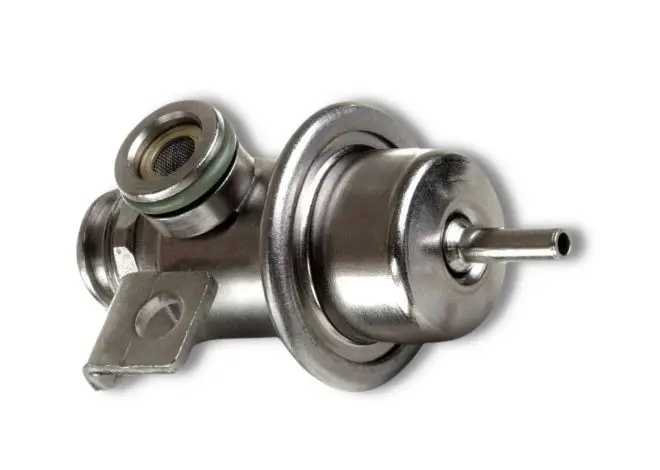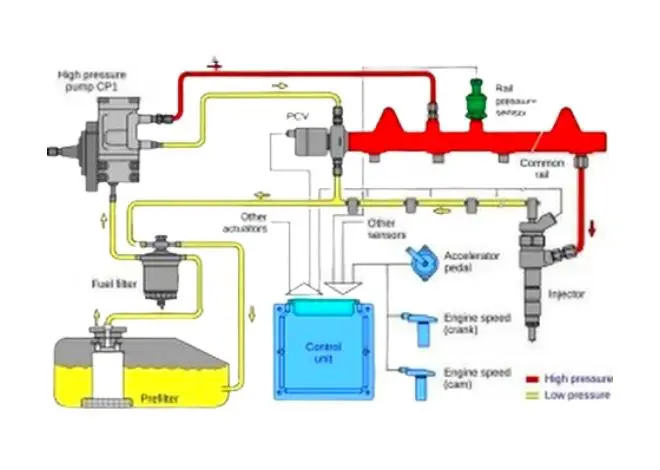Last Updated on May 21, 2025
Having a car brings convenience, independence, and joy—but it also comes with responsibilities. If you’re a vehicle owner, you may encounter various diagnostic trouble codes (DTCs) when your vehicle’s onboard diagnostics system (OBD2) detects issues. One such code that you may see is the P0001 code.
This code is more than just a random string of characters—it’s a specific warning related to your car’s fuel system. In this article, we’ll walk you through everything you need to know about the P0001 code, including its meaning, causes, symptoms, how to fix it, and how much it might cost you. We’ll also discuss related codes like P0002 and P0003 so you can be fully informed.
What Is the P0001 Code?
P0001 = Fuel Volume Regulator Control Circuit – Open
The P0001 code indicates a problem with the fuel volume regulator control circuit. This circuit is essential for regulating the amount of fuel sent to your engine. It’s a part of the high-pressure fuel system, and it connects the Engine Control Module (ECM) to the Fuel Volume Regulator (FVR) located on the fuel rail.
When the ECM detects that the control circuit is “open” or disconnected, it triggers the Check Engine Light (CEL) and logs the P0001 code in your vehicle’s memory. This is often a sign that there’s a wiring issue, a faulty component, or an open circuit disrupting fuel flow.
Why the P0001 Code Shouldn’t Be Ignored
You might think that a minor warning light is harmless, but ignoring the P0001 code can lead to serious issues. Since it directly affects fuel pressure regulation, it can reduce fuel efficiency, cause engine misfires, and even damage the catalytic converter if left unresolved. To avoid these costly repairs, you should address this trouble code as soon as it appears.
For more insight into what other warning signs could mean for your car, check out our guide on the U0001 code, which covers communication errors between control modules.
Where Is the Fuel Volume Regulator Located?
The Fuel Volume Regulator is typically located on the fuel rail, near or attached to the fuel pump, depending on your vehicle make and model. This part works directly with the ECM to ensure your engine gets the correct amount of fuel under different driving conditions.
If you’re also experiencing issues like poor acceleration or black smoke from the exhaust, consider reading our article on blown fuse in car symptoms to identify whether electrical faults are contributing to the problem.
What Happens in the Fuel Volume Regulator Control Circuit?
The fuel volume regulator operates through an electronic circuit. Here’s how it works:
- The ECM sends voltage to the Fuel Volume Regulator (FVR).
- The FVR controls how much fuel is allowed into the fuel rail.
- If the circuit is open (i.e., disconnected or broken), fuel flow becomes irregular or stops completely.
- The ECM then sets the P0001 code, which triggers the Check Engine Light and possibly sends your car into limp mode.
What Causes the P0001 Code? — Common Triggers Explained
When your vehicle displays the P0001 code, it’s a clear signal that something within the fuel volume regulator control circuit has malfunctioned. This issue often stems from either electrical or mechanical problems—but pinpointing the root cause can save you both time and repair costs.
Below are the most common reasons the P0001 trouble code appears on your diagnostic scanner.
1. Damaged or Corroded Wiring in the Fuel Circuit
One of the most frequent causes of the P0001 code is faulty wiring. Over time, wires connecting the ECM to the Fuel Volume Regulator can:
- Become frayed
- Develop corrosion
- Suffer rodent damage
- Disconnect due to vibrations or engine heat
Even minor electrical faults can result in an “open circuit,” which triggers this diagnostic trouble code.
If you’re curious about how electrical problems impact your car’s diagnostics, we recommend reading our article on freeze frame data.
2. Loose or Faulty Connectors
Just like damaged wires, loose connectors between the fuel pressure regulator and the ECM can break the electrical path. Mechanics often overlook these tiny components, even though they’re crucial to maintaining stable fuel flow and pressure.
3. Fuel Volume Regulator Failure
The Fuel Volume Regulator (FVR) itself can fail due to:
- Internal mechanical wear
- Exposure to contaminated fuel
- Electrical shorting or burnout
When this component fails, it can no longer regulate fuel pressure properly, leading to performance issues and the P0001 diagnostic code.
4. Fuel Pump Malfunction
Since the FVR works closely with the fuel pump, any issues with fuel delivery can also set off the P0001 code. A weakened or broken fuel pump might not be able to maintain pressure, causing the regulator to behave abnormally.
To learn more about fuel delivery problems and how to test them, see our guide on how to test your car battery with a multimeter—a useful skill for any DIYer dealing with car diagnostics.
5. Faulty Engine Control Module (ECM)
Although it’s rare, a failing ECM can also trigger false codes, including the P0001 code. If the ECM cannot communicate correctly with the fuel system or misinterprets sensor data, it may incorrectly assume there’s an open circuit.
6. Clogged Fuel Filters or Hoses
Clogs or blockages in the fuel lines, filters, or hoses can reduce the overall fuel pressure in the system. While not always directly responsible for the P0001 code, they can contribute to inconsistent flow that mimics a regulator failure.
For similar cases where vehicle performance issues hint at underlying system faults, read our breakdown on bad clutch master cylinder symptoms.
How to Diagnose the P0001 Code — Step-by-Step Guide
Diagnosing the P0001 code properly is essential before jumping into repairs. Whether you’re a DIYer with some experience or consulting a professional mechanic, understanding the fuel volume regulator control circuit is key to resolving the issue.
Let’s go through the complete diagnostic process step by step.
Step 1: Connect an OBD2 Scanner
The first step in diagnosing any trouble code is to scan your vehicle’s onboard computer system using a professional-grade OBD2 scanner.
- Plug the scanner into the OBD2 port (usually under the steering wheel).
- Turn on the ignition and allow the scanner to read the data.
- If P0001 code appears, record any other codes that accompany it (such as P0002 or P0003).
A high-quality scanner can also pull live data from the fuel system and show fuel pressure in real time.
💡 Want to know more about using a scanner? Read our complete tutorial on how to use freeze frame data to help spot hidden issues.
Step 2: Visual Inspection of Wiring and Connectors
Next, visually inspect the fuel volume regulator control circuit:
- Check all wiring harnesses between the ECM and the Fuel Volume Regulator (FVR).
- Look for signs of frayed wires, corrosion, burn marks, or loose connections.
- Don’t forget to inspect connectors near the fuel rail and fuel pump.
🔧 Many mechanics overlook these simple checks and go straight to expensive repairs—don’t make that mistake!
Step 3: Check Voltage with a Digital Multimeter
If the wiring looks fine, use a digital multimeter to test voltage across the FVR circuit.
- Measure the resistance between key points in the circuit.
- A reading of infinite resistance indicates an open circuit—confirming the core problem behind the P0001 code.
- Verify that the FVR is receiving correct voltage input from the ECM.
For accurate multimeter testing, see our detailed guide on how to test a car battery, which includes safety tips and voltage range explanations.
Step 4: Fuel Pressure Testing
The next step is to test fuel pressure using a fuel pressure gauge.
- Compare the pressure readings to the manufacturer’s specifications.
- Low or no fuel pressure may indicate a faulty fuel pump, clogged filter, or stuck regulator.
If you also suspect smoke or unusual smells from your exhaust, check out symptoms of a bad starter—since poor ignition and fuel delivery sometimes overlap in symptoms.
Step 5: Use Advanced ECM Diagnostic Tools
Professional technicians often use advanced diagnostic tools that can:
- Access ECM live data streams
- Simulate signal input/output
- Test individual actuators and valves (like the VCV)
This step helps confirm whether the Engine Control Module is sending or receiving the correct signals.
Quick Tip: Don’t Skip the Basics
One of the most common mistakes in diagnosing the P0001 trouble code is skipping over small but critical parts—like checking connector pins, cleaning ground points, or overlooking software glitches in the ECM.
How Serious Is the P0001 Code and How Can You Fix It?
The P0001 code might not seem urgent at first glance, especially if your vehicle still starts and runs. But don’t be fooled—this code can escalate into critical engine damage if ignored.
🚨 How Serious Is the P0001 Code?
The P0001 code directly impacts your car’s fuel delivery system—which plays a vital role in how the engine operates. If left unchecked, you may experience:
- Engine misfires or rough idling
- Sudden stalling or failure to start
- Poor fuel economy
- Loss of acceleration
- Catalytic converter damage from excessive unburned fuel
In worst-case scenarios, your vehicle may enter limp mode, drastically reducing performance to protect critical components. This is why we strongly recommend diagnosing and fixing this issue immediately.
You can also check out our article on C0035 code to learn how seemingly minor codes can signal major safety concerns.
How to Fix the P0001 Code (Step-by-Step)
After proper diagnosis, here are the typical steps to resolve the P0001 fuel volume regulator control circuit open issue:
✅ 1. Clear the Trouble Code
- Use your OBD2 scanner to reset the code after identifying and fixing the cause.
- Take the car for a test drive to see if the Check Engine Light (CEL) reappears.
✅ 2. Repair or Replace Damaged Wiring
- Fix frayed or exposed wires using heat shrink tubing or electrical tape.
- Replace any melted, corroded, or broken connectors.
✅ 3. Inspect and Replace the Fuel Volume Regulator
- If faulty, install a new FVR as per your car’s manufacturer specifications.
- Ensure all connections are properly sealed and tight.
✅ 4. Replace the Fuel Pump (if needed)
- If the pump is weak or not maintaining pressure, replace it with an OEM-grade unit.
- Also inspect the fuel filter, lines, and seals for debris or blockages.
✅ 5. ECM Software Update or Replacement
- In rare cases, the Engine Control Module (ECM) may need a software update.
- If damaged, a replacement might be necessary, though this is often a last resort.
✅ 6. Re-test With the Scanner
- Once repairs are made, re-scan the system.
- If no codes appear and the fuel pressure is stable, the issue is resolved.
❌ Common Mistakes to Avoid During Repair
Many car owners and even some technicians make these costly errors when dealing with the P0001 code:

- Replacing the fuel pump too early, without checking wiring or the regulator.
- Overlooking corroded connectors or small wiring faults that seem insignificant.
- Failing to test the ECM or update its software before replacement.
- Neglecting the fuel tank and filter, which may contain debris that interferes with fuel pressure.
If you want to learn more about mistakes that can lead to bigger problems, read our guide on bad brake light switch symptoms—another small issue that can create large complications.
Estimated Repair Cost for P0001 Code
Repair costs will vary depending on the cause:
| Component | Estimated Cost (USD) |
|---|---|
| OBD2 Diagnostic Scan | $80 – $120 |
| Wiring and Connector Repairs | $50 – $200 |
| Fuel Volume Regulator Replacement | $150 – $300 |
| Fuel Pump Replacement | $300 – $800 |
| ECM Replacement | $500 – $1,500+ |
The total cost can rise quickly if multiple components are affected. That’s why a correct diagnosis is critical before starting any repairs.
Related OBD-II Trouble Codes to P0001
If your scanner shows P0001, there’s a good chance one or more of the following codes may also appear:
- P0002 code: Fuel Volume Regulator Control Circuit Range/Performance
- P0003 code: Fuel Volume Regulator Control Circuit Low
- P0004 code: Fuel Volume Regulator Control Circuit High
- P0000 code: No Diagnostic Trouble Code found (usually appears with false readings or scanner errors)
If you’re seeing multiple codes like these, it’s likely your fuel system circuit has a broader problem that needs to be addressed holistically—not just component by component.
How to Prevent the P0001 Code from Reappearing
Here are some simple maintenance tips to reduce the likelihood of the P0001 code or its related faults returning:
🛠️ Perform Regular Fuel System Maintenance
- Use high-quality fuel and add fuel system cleaners periodically.
- Replace your fuel filter as recommended by the vehicle’s service schedule.
- Inspect the fuel pressure regulator, fuel rail, and lines during routine maintenance.
🔌 Inspect Electrical Connections Frequently
- Every few months, especially in humid or dusty areas, inspect the wiring and connectors for corrosion or looseness.
- Use dielectric grease to protect sensitive connections in the fuel control circuit.
🚗 Use a Scan Tool Regularly
- Periodically scan your vehicle even when no check engine light is present.
- This helps you catch early warning signs and stay ahead of potential issues.
💻 Update ECM Software
- Ensure your car’s ECM is updated with the latest software patches, especially if you’re driving a modern vehicle.
- Updates can improve fuel system logic and reduce false positives like the P0001 code.
Final Thoughts: Don’t Ignore the P0001 Code
The P0001 code may start as a simple open-circuit error in your vehicle’s fuel pressure regulation system, but it can snowball into major engine performance issues or even engine damage if left unresolved. Thankfully, with a systematic approach—diagnosing the problem, inspecting connections, replacing faulty parts, and clearing the code—you can get your car back to full performance without breaking the bank.
Quick Summary of the P0001 Code Article
| Aspect | Details |
|---|---|
| Meaning | Fuel Volume Regulator Control Circuit – Open |
| Symptoms | Check Engine Light, poor performance, hard starting, low fuel efficiency |
| Common Causes | Damaged wiring, faulty FVR, failing fuel pump, ECM issues |
| Diagnosis Tools | OBD2 scanner, multimeter, fuel pressure gauge |
| Fix Methods | Repair wiring, replace fuel volume regulator or pump, reprogram/update ECM |
| Repair Cost Range | $120 – $1,500 depending on cause |
| Prevention Tips | Routine fuel system checks, ECM updates, electrical inspections |
🔗 Recommended Articles for Further Reading
- U0001 Code – What it Means and How to Fix It
- Blown Fuse in Car Symptoms
- Symptoms of a Bad Starter
- How to Test a Car Battery With a Multimeter
Conclusion
The P0001 code is more than just a technical glitch—it’s a clear warning that your vehicle’s fuel system is compromised. Fortunately, this guide has walked you through everything: from what the code means, its causes and symptoms, to how to diagnose and fix it effectively. Take prompt action, stay proactive with maintenance, and you’ll protect your engine, fuel economy, and wallet in the long run.
If this guide helped you fix or understand the P0001 code, be sure to explore more car repair tips on The Effective Guide for everything from OBD-II codes to battery testing and more.
Meet our professional car mechanic, Russell D. Steele, who has been in this field for five consecutive years and works with several automotive companies. He completed the "AUTOMOTIVE & LIGHT DUTY DIESEL TECHNOLOGY" course from NorthWest Lowa Community College, where he learned essential diagnostic and transportation management skills and became a certified mechanic.
